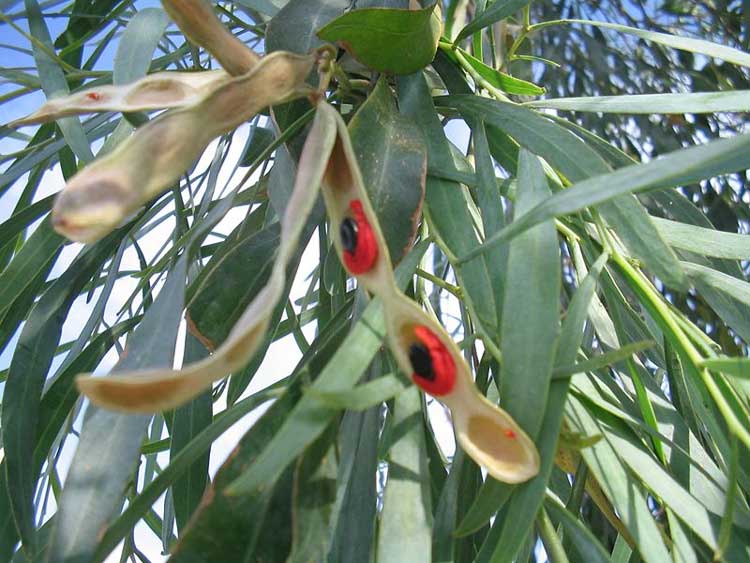
Acacia salicina (*)
Classification System: APG IV
Superregnum: Eukaryota
Regnum: Plantae
Cladus: Angiosperms
Cladus: Eudicots
Cladus: Core eudicots
Cladus: Rosids
Cladus: Eurosids I
Ordo: Fabales
Familia: Fabaceae
Subfamilia: Caesalpinioideae
Tribus: Acacieae
Genus: Acacia
Species: Acacia salicina
Name
Acacia salicina Lindl., 1838
Synonyms
Acacia salicina var. varians Benth.
Acacia varians Benth.
Racosperma salicinum (Lindl.) Pedley
Distribution
Native distribution areas:
References
Primary references
Lindley, J. in Mitchell, T.L. 1838. Three Expeditions into the interior of Eastern Australia: with descriptions of the recently explored region of Australia Felix, and of the present colony of New South Wales. 2. Project Gutenberg, Archive.org Reference page. : 2:20.
Links
Govaerts, R. et al. 2020. Acacia salicina in Kew Science Plants of the World online. The Board of Trustees of the Royal Botanic Gardens, Kew. Published online. Accessed: 2020 Aug 13. Reference page.
International Plant Names Index. 2019. Acacia salicina. Published online. Accessed: Aug 13 2019.
Tropicos.org 2019. Acacia salicina. Missouri Botanical Garden. Published online. Accessed: 13 Aug 2019.
Catalogue of Life: 2021 Annual Checklist
Acacia salicina – Taxon details on World Wide Wattle.
USDA, ARS, Germplasm Resources Information Network. Acacia salicina in the Germplasm Resources Information Network (GRIN), U.S. Department of Agriculture Agricultural Research Service. Accessed: 09-Oct-10.
Vernacular names
English: Broughton Willow, Cooba, Doolan, Native Wattle, Native Willow, Willow Acacia, Willow Wattle
Acacia salicina is a thornless species of Acacia tree native to Australia.
Common names include cooba, native willow, willow wattle, Broughton willow, Sally wattle and black wattle.
It is a large shrub or small evergreen[2] tree growing up to 45 feet tall. Fast grower dropping lots of leaf litter. It has a life span of about 10–50 years. In the Northern Hemisphere, Acacia salicina flowers primarily from October to January and the seed pods are often visible from April to July.[3] The tree's seeds are shiny, black and have a crimson appendage-like aril.[4] Acacia salicina is "closely related" to Acacia ligulata[5] and Acacia bivenosa.[6]
Chemical compounds
Wood
(−)-7,8,3',4'-tetrahydroxyflavanone[7]
7,8,3',4'-tetrahydroxydihydroflavonol[7]
7,8,3',4'-tetrahydroxyflavonol[7]
Natural growing conditions
Acacia salicina is found parts of Eastern Australia. The average yearly precipitation over the entire range is 375-550mm, with the plant itself found growing in regions receiving in excess of 1500mm annually in northern Queensland and as low as 100mm annually in central Australia. Its natural altitude range is from 50-300m above sea level.[4] It does well in full sun exposure and it tolerates frosts down to -6.7 deg. C (-20 deg. F).[2]
Uses
Acacia salicina
Erosion management
Acacia salicina can be used to help stabilize riverbanks and other areas.[8]
Fodder
The tree's foliage and seed pods are important fodder for livestock during dry periods, since the tree can withstand drought quite well.[8] Its foliage and pods compare quite poorly to other fodders with regard to digestibility by livestock. This affects its available nutritional value.[9] The 1889 book 'The Useful Native Plants of Australia’ records that "The leaves are eaten by stock. This is another tree which is rapidly becoming scarce, owing to the partiality of stock to it."[10]
Food
The seeds are edible.[8]
Landscaping
Acacia salicina branches with seed pods
Acacia salicina is excellent for landscaping in dry areas.[8]
Tannin
The bark has a high tannin content.[8]
Wood
Acacia salicina Bark
The wood is very hard and it is used in making fine furniture.[8] At one time, the tree's wood was used in the manufacture of axles for wagon wheels. Acacia salicina's wood burns nicely and makes good fuel.[8] Its calorific content is 18900kJ/kg dry mass.[9] The tree produces seed and timber for woodworking in as little as five years after planting.[11]
Other uses
The bark has been traditionally put to use by Indigenous Australians as a toxin for fishing.[8] The leaves of A. salicina are thought to be psychoactive, since indigenous Australians "burn its leaves and smoke the ash to obtain a state of inebriation."[12]
The 1889 book, The Useful Native Plants of Australia, records that common names included "Native Willow" and "Broughton Willow" near the Broughton River in South Australia. It also records it was called "Cooba" or "Kooba" by Indigenous people in Western New South Wales and "Motherumba" by those on the Castlereagh River, New South Wales.[10]
Weed status
Acacia salicina spreads widely through seed dispersal, and individual trees can rapidly form thickets through production of adventitious shoots from the root system. The species has become a significant weed over some of its native,[9][13] and introduced range.[14]
References
"ILDIS LegumeWeb (version 10)". Ildis.org. Retrieved 15 March 2022.
Gardens At Carefree Town Center - Plant Identification List Archived April 8, 2008, at the Wayback Machine
PDF Ursula K. Schuch and Margaret Norem, Growth of Legume Tree Species Growing in the Southwestern United States, University of Arizona.
"Species Bank Treatment for Acacia Salicina". Environment.gov.au. Retrieved 15 March 2022.
"Fact Sheet for Acacia ligulata". Archived from the original on 2007-08-29. Retrieved 2007-06-17.
"Acacia ligulata - WATTLE". Worldwidewattle.com. Retrieved 15 March 2022.
Clark-Lewis, J. W.; Nair, V. (15 March 1964). "Flavan derivatives. X. 7,8,3',4'-Tetrahydroxyflavanone and 7,8,3',4'- Tetrahydroxydihydroflavonol from Acacia species". Australian Journal of Chemistry. 17 (10): 1164–1169. doi:10.1071/ch9641164. Retrieved 15 March 2022.
Acacia Salicina, Csu.edu.au
"Acacia Search" (PDF). Worldwidewattle.com. Retrieved 15 March 2022.
J. H. Maiden (1889). The useful native plants of Australia : Including Tasmania. Turner and Henderson, Sydney.
Victorian Landcare & Catchment Management, Autumn 2003 Issue 27 p. 8
Yaniv, Zohara; Bachrach, Uriel (25 July 2005). "Handbook of Medicinal Plants". CRC Press. p. 183. Retrieved 15 March 2022 – via Google Books.
"Listed invasive native species by Catchment Management Authority" (PDF). Archived from the original (PDF) on 2008-07-19. Retrieved 2014-01-06.
"Invasive Plants Database". Invasive.m-fuukei.jp. Retrieved 15 March 2022.
Retrieved from "http://en.wikipedia.org/"
All text is available under the terms of the GNU Free Documentation License

